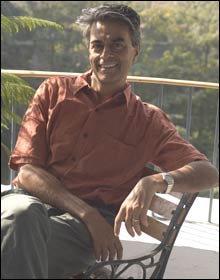
UPAMANYU CHATTERJEE: A lyrical comedy about an Indian slacker. |
Here, listed alphabetically by author, are 10 of the best fiction and poetry books the Phoenix wrote about in 2006.1.Julian Barnes | Arthur & George | Knopf | In a time of tenuous allegiances and deep culture clashes, Julian Barnes’s novel asks, “What determines nationality? What does it mean to be included, to be excluded?” Set in Late Victorian England and based on a true story, Arthur & George alternates sections headed “Arthur” (Sir Arthur Conan Doyle, creator of Sherlock Holmes) and “George” (a half-Indian Staffordshire solicitor whose tidy, provincial existence is disrupted when he’s accused of hideous crimes). Barnes’s language takes in Kipling’s florid prose, Gilbert & Sullivan’s lilt, Mrs. Gaskell’s delicacy, and Elgar’s pomp, merging elements of the Victorian thriller and romance to tell a whopping good tale with unsettling existential and moral implications.
2.Upamanyu Chatterjee | English, August: An Indian Story | New York Review Books | Originally published in India in 1988, this American debut can be shelved along with the work of Chatterjee’s compatriots, but a few delightful differences set it apart, the most obvious being its protagonist, Agastya Sen, a 24-year-old slacker whose primary activities are masturbating, smoking pot, and contemplating his place in the larger order of things. Unlike the uneasily acclimatized expatriates of Jhumpa Lahiri’s fiction, Sen has remained in his home country. Yet he experiences the same feelings of rootless confusion.
3.Richard Ford | The Lay Of The Land | Knopf | In what he says will be the last of his Frank Bascombe novels — which began in 1986 with The Sportswriter and continued in the Pulitzer-and-PEN/Faulkner-Award-winning Independence Day — Ford follows his protagonist, a philosophical novelist-turned-sportswriter-turned-real-estate-agent, over three days that culminate in Thanksgiving 2000. Contending with prostate cancer, two challenging adult children, an ex-wife, a current marriage at risk, and a Tibetan Buddhist employee named Mike Mahoney, Bascombe is grouchy, likable, garrulous, infinitely observant. Deploying him against the backdrop of the Jersey shore, Ford makes an implicit argument about the novel not merely as a depiction of the world but as a mode of thought.
4.Etgar Keret | The Nimrod Flipout | Farrar, Straus and Giroux | The Tel Aviv author is a deadpan surrealist chronicling the intrusion of the bizarre into the quotidian: a man’s girlfriend turns, every night, into a bald potbellied soccer fanatic; devoted parents shrink an inch for every inch their son grows; a booklet advertised in the newspaper teaches humanity the meaning of life for only $9.99; a beloved pet dog keeps coming back from the dead; a beautiful little girl covets the glittering eyes of the grubby, ordinary little boy who’s in love with her. But Keret’s weirdness is never without a recognizable emotional component, and at their best these stories work as elegant metaphors.